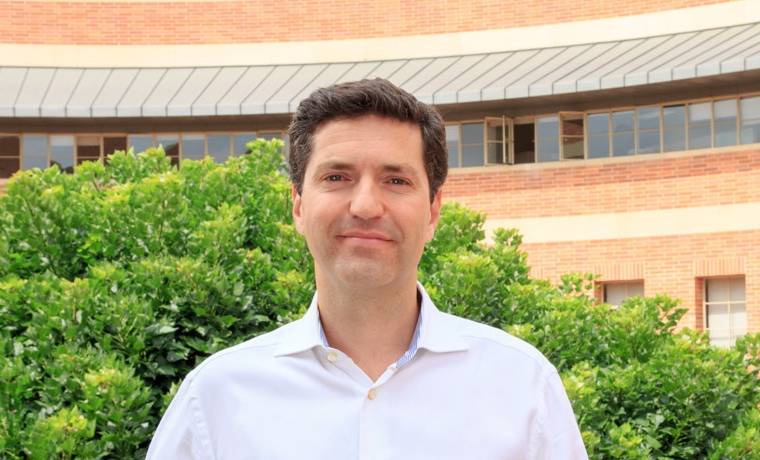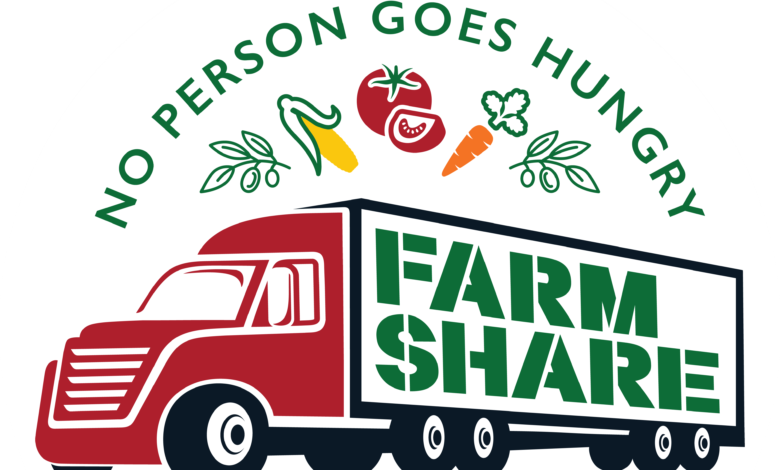
How Senior Living Executives Help Farm Share Feed Florida’s Hungry
By Jim Nelson | July 31, 2024
Together with its sister company, HEALTHTAC, Senior Living News produces three highly productive, senior-level executive events each year. HEALTHTAC’s sister company, BITAC, produces many more similar events for the hospitality industry.
At these events, HEALTHTAC and BITAC engage in a networking activity that 1) engenders conversations between our attendees and 2) raises money for a local charity. Through the end of 2025, HEALTHTAC and BITAC have a dozen such events scheduled in Florida, and when we hold them in Florida, we typically share that money with Farm Share.
Why Farm Share? Since 1991, Farm Share has fed millions of food-insecure Floridians and saved millions of pounds of food from going to waste — all free of charge.
 Since 1991, Farm Share has led the battle to fight food insecurity in Florida by collecting in bulk unsold produce that doesn’t meet market standards because of size or minor imperfections. That food is then washed, sorted, and packed by volunteers and inmate labor, and distributed to participating nonprofits — soup kitchens, food pantries, homeless shelters, churches, and senior centers serving the homeless and low-income households throughout the state.
Since 1991, Farm Share has led the battle to fight food insecurity in Florida by collecting in bulk unsold produce that doesn’t meet market standards because of size or minor imperfections. That food is then washed, sorted, and packed by volunteers and inmate labor, and distributed to participating nonprofits — soup kitchens, food pantries, homeless shelters, churches, and senior centers serving the homeless and low-income households throughout the state.
So many of our readers have played a part in these donations to Farm Share by participating in HEALTHTAC’s and BITAC’s networking activities and peanut butter & jelly challenges (an exhilarating team-building event that helps HEALTHTAC and BITAC donate hundreds of PB&J sandwiches to local hungry people each time), that we wanted to spotlight what Farm Share does.
For that we jumped on a call with CEO Stephen Shelley, who joined Farm Share as COO in 2016 after having spent a decade operating his own family law, business law, and general civil litigation practice. He also spent some time in local politics, serving as a councilman, vice mayor, and mayor in his home city. Promoted to CEO in July 2019, following the retirement of founder Patricia Robbins, Shelley has, in his five years at the Farm Share helm, nearly quadrupled the pounds of food that it has acquired and distributed.
SENIOR LIVING NEWS: Recent numbers say that about 44 million people in the United States face hunger, including one out of every five children. In Florida, where you are, about 11 and a half percent of all households were food insecure during the pandemic years. Are those numbers getting better or worse?
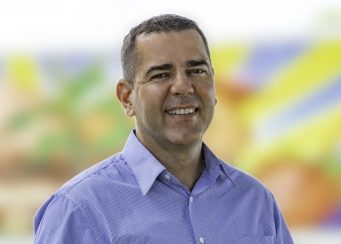
STEPHEN SHELLEY: We’re seeing more of a worsening of those numbers: as of ’22, ’23, it’s more about 12.8 percent nationwide that are suffering from food insecurity. You have a two or almost three percent increase from say 2019 to 2022, 2023. Those numbers are continuing to climb. Outside of the statistical side of things you’re seeing it in the lines of people that are coming to our food distribution events, or the amount of people that are utilizing services with our partner agencies or partner pantries; they need more food because their rosters are growing. We’re also seeing that who is utilizing the services is changing, because of all this inflation that we’ve had. It started back during the pandemic, but inflation that fall was really, I think, worse than the pandemic, because the pandemic was short-term in terms of things [being] shut down. You had this immediate loss of income, but at some point, programs came in that helped offset that, the world started back up again, people went back to work, but the inflation isn’t a short-term issue. So, although today we talk about the annualized inflation is maybe down to three or four percent, which is better than nine percent, but that three or four percent is on top of the nine percent the year prior, and so your overall increase is still up; it’s not going down, things aren’t getting better. That’s really the driving force behind where this food insecurity is increasing.
SLN: Tell us about the work that Farm Share does.
SS: Farm Share was founded on a groundbreaking idea at that time. They were the first to even think about this concept utilizing underutilized fruits and vegetables that farmers were essentially throwing away, not because they weren’t edible, not because they weren’t healthy, nutritious, but simply because they were blemished, or they were too big or too small to fit the grocery store packaging — those were considered by that industry to be garbage and therefore dumped either in a landfill or back into the fields. Our founder was at a local farmers market and saw these dump trucks leaving full of this product and thought, ‘There’s got to be some way that we can take that product and use it to feed the hungry.’ That was the original concept of Farm Share.
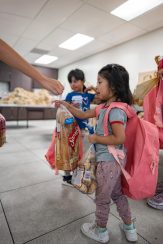 Since that time, we’ve grown and expanded; we also now are part of other non-perishable food products — proteins, dairy products — that we are getting donated to us. It’s one of the things that we do different than I’d say a lot of other food banks in the United States is that we’re not paying people for that food. We’re giving them a tax deduction, and because they’re donating that food to us, we’re able to take all the monies that we get in our operational side to move that food. Because we’re able to get our food donated historically, Farm Share is able to use those dollars that would have been needed to buy the food and use it [instead] to move more food, store more food, acquire more food, and ultimately distribute more food.
Since that time, we’ve grown and expanded; we also now are part of other non-perishable food products — proteins, dairy products — that we are getting donated to us. It’s one of the things that we do different than I’d say a lot of other food banks in the United States is that we’re not paying people for that food. We’re giving them a tax deduction, and because they’re donating that food to us, we’re able to take all the monies that we get in our operational side to move that food. Because we’re able to get our food donated historically, Farm Share is able to use those dollars that would have been needed to buy the food and use it [instead] to move more food, store more food, acquire more food, and ultimately distribute more food.
Within that we have a bunch of different programs that we operate, whether it be seniors or food deserts — we even have a program where we use the power of food to affect crime rates and increase community relations between police officers and the communities that they serve. We’ve found that to be very successful.
SLN: Elaborate, if you would, on how you’ve used food to help with police and crime.
SS: We started this right before I came to work for Farm Share [in] 2016. There was a pilot program that was performed by the State Attorney’s Office and Farm Share where they decided to do food distribution events in a high-crime/low-income, food-insecure community to see if they were able to provide that community with reoccurring staples of life — in this case food — would it have an effect on the crime? After a year they did find that crime rates did go down within those communities in which they had those reoccurring events, but I think the headline ended up being the improvement in law enforcement/community relations that came from those events; that ended up being the focus going forward. Yes, crime would be reduced, but more importantly you were able to build bridges between law enforcement in communities that historically had shunned law enforcement, or would not communicate with law enforcement, and instead build pretty good relationships to the point where we had success stories where communities [that] historically would not have reached out to law enforcement, because of that relationship and the trust and the bond that had been able to form through these events, would reach out and actually say, ‘So and so is the one that you’re looking for.’ So, it was really successful.
SLN: That is so fantastic. How many warehouses, trucks, things of that nature, do you have operating for you right now?
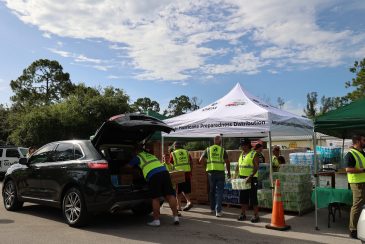 SS: We have eight regional warehouses: two in Miami-Dade County; two in Broward; one in Palm Beach, along with a large-scale partner in Palm Beach as well; we have one in Palatka; one in Duval County, there in Jacksonville, and one over in Quincy, which is just outside of Tallahassee. We have about 55 semi-trucks and box trucks, all refrigerated, that we use to either pick food up, distribute food, or move around the entire state. Areas [where] we don’t have a warehouse we have identified large-scale partner agencies — large-scale food banks or large-scale food pantries that can take multiple semi-trucks on a weekly basis. We’re distributing our food to them, and they’re then redistributing that food [to] local pantries; that’s how we’re able to serve areas like Tampa Bay. We don’t have a warehouse directly in Tampa Bay, but each year we distribute probably three, four million pounds of food into those areas and that’s through these large-scale partnerships that we have. That’s been really successful for us.
SS: We have eight regional warehouses: two in Miami-Dade County; two in Broward; one in Palm Beach, along with a large-scale partner in Palm Beach as well; we have one in Palatka; one in Duval County, there in Jacksonville, and one over in Quincy, which is just outside of Tallahassee. We have about 55 semi-trucks and box trucks, all refrigerated, that we use to either pick food up, distribute food, or move around the entire state. Areas [where] we don’t have a warehouse we have identified large-scale partner agencies — large-scale food banks or large-scale food pantries that can take multiple semi-trucks on a weekly basis. We’re distributing our food to them, and they’re then redistributing that food [to] local pantries; that’s how we’re able to serve areas like Tampa Bay. We don’t have a warehouse directly in Tampa Bay, but each year we distribute probably three, four million pounds of food into those areas and that’s through these large-scale partnerships that we have. That’s been really successful for us.
SLN: In the six years that you’ve been with Farm Share, you have nearly quadrupled the amount of food that you acquire and distribute; you have increased the number of meals that you serve every year to more than 98 million, and the number of community food distributions that you hold now, statewide, is in excess of 800 per year. You’ve also nearly tripled the number of regional warehouses that you operate. What are your goals for Farm Share over the next few years?
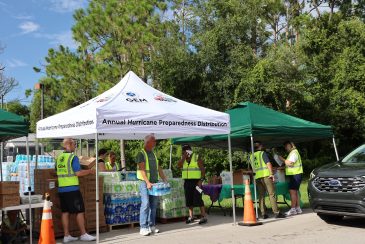 SS: We still are looking to do some expansion, fill in some gaps warehousing wise. I’d love to get a warehouse somewhere in that Tampa/Orlando-ish area, to fill in that side of the state where I don’t have a direct warehouse. That’s been a long-term plan, assuming I can find funding and the right location and things of that nature. But in terms of programming, which I think is relevant to what you’re writing about, one of the things that we found during the pandemic was that all these drive-thru events and all the things were taking place, our agencies were in full swing, but it left out people who were unable to get to these events. If you don’t have an ability to get to one of the places where we’re distributing food or one of our agencies is distributing food, then you’re still without means to [receive] that healthy, nutritious food. So, one of the things we’re looking to get into and we’re starting to try to launch a pilot program with Miami-Dade County now is home delivery. Identifying homebound seniors, homebound disabled, who are not able to physically get to one of our food access points, and then be able to deliver that food directly to them. We did something similar with Jacksonville during the pandemic, where they put to use all of their buses and other transportation systems that were shut down and gave us access to that, they put together a list of people who are homebound and we were able to provide the food and deliver it directly to those people. That was something that we had never been able to do before and not many other organizations have done. So, we’re looking to see how we can enter that field a little bit. By having some sort of an ability to identify and focus on homebound people, not necessarily everybody, but still, it does open the door up to potentially expand that to other means to deliver food in rural communities where you’re driving 20, 30 miles to find the nearest food pantry or the nearest grocery store. That’s the area where we’re really focused on. We’ll develop that over the next year probably to see what works through this pilot system.
SS: We still are looking to do some expansion, fill in some gaps warehousing wise. I’d love to get a warehouse somewhere in that Tampa/Orlando-ish area, to fill in that side of the state where I don’t have a direct warehouse. That’s been a long-term plan, assuming I can find funding and the right location and things of that nature. But in terms of programming, which I think is relevant to what you’re writing about, one of the things that we found during the pandemic was that all these drive-thru events and all the things were taking place, our agencies were in full swing, but it left out people who were unable to get to these events. If you don’t have an ability to get to one of the places where we’re distributing food or one of our agencies is distributing food, then you’re still without means to [receive] that healthy, nutritious food. So, one of the things we’re looking to get into and we’re starting to try to launch a pilot program with Miami-Dade County now is home delivery. Identifying homebound seniors, homebound disabled, who are not able to physically get to one of our food access points, and then be able to deliver that food directly to them. We did something similar with Jacksonville during the pandemic, where they put to use all of their buses and other transportation systems that were shut down and gave us access to that, they put together a list of people who are homebound and we were able to provide the food and deliver it directly to those people. That was something that we had never been able to do before and not many other organizations have done. So, we’re looking to see how we can enter that field a little bit. By having some sort of an ability to identify and focus on homebound people, not necessarily everybody, but still, it does open the door up to potentially expand that to other means to deliver food in rural communities where you’re driving 20, 30 miles to find the nearest food pantry or the nearest grocery store. That’s the area where we’re really focused on. We’ll develop that over the next year probably to see what works through this pilot system.




